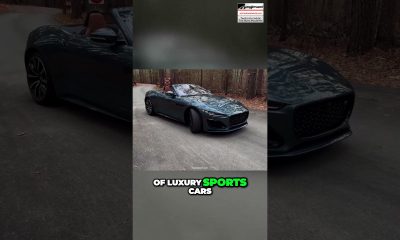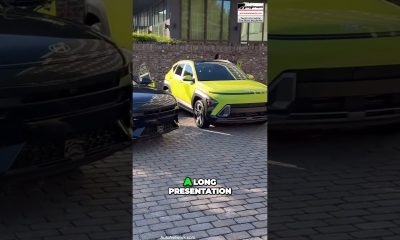Transportation
Auto Review: 2017 Nissan Maxima

By Frank S. Washington (NNPA Newswire Auto Critic)
DETROIT – Nissan continues to brand its flagship sedan as a 4-door sports car. And though it was just introduced last year, the automaker has tweaked the 2017 Nissan Maxima.
If you’re going to bill anything as a sports car, then one of the most important elements lays under the hood. Sixty percent of its 3.5-liter V6 engine is new. Engineers borrowed technology from the company’s supercar, the Nissan GT-R, like sodium-filled valves. The motor made 300 horsepower and 261 pound-feet of torque.
This re-engineering increased fuel economy from the previous Maxima by 15 percent. The car was rated at 21-mpg in the city, a healthy 30-mpg on the highway and 25-mpg combined.
Nissan has focused a lot of time and money on its continuously variable transmission (CVT), and the gearbox, which has no gears in the traditional sense, is in the third generation of production and it shows. CVTs can be loud, and because they don’t change gears they’re apt to drone. Many drivers think there’s something wrong with the car. We think that’s why automakers in general have walked away from the technology.
But Nissan has stuck with it. To assuage drivers, they’ve quieted that drone and they’ve configured their CVT, which they branded Xtronic, to simulate gearshifts. The transmission was relatively quiet and we did feel it simulate shifts.
There was a bit of drone, but overall the transmission enabled the car to be pretty quick. And one of the things we discovered was that the Maxima had great acceleration from 30 to 60 mph, when you really need to get out of the way or pass somebody.
The transmission also had drive modes: normal and sport. We didn’t use it much, but the feature adjusts throttle response, transmission tuning, steering feel and Active Sound Enhancement tuning.
In sport mode, the engine throttle response increases, the Xtronic transmission programming changes for more aggressive shifting under braking and gear holding, the steering weight increases and the Active Sound Enhancement system further amplifies the engine note in the cabin.
The chassis featured high strength steel that led to a 25 percent increase in torsional rigidity and reduced weight by 82 lbs. The suspension was an independent subframe-mounted strut/coil spring design in front. And in the rear was an independent multi-link double wishbone design. That’s a bit of tech-talk.
For the uninitiated it means that the car had a really smooth ride. It cornered well, handled the ruts of urban streets without any problem, and for the most part kept the urban rumble of city streets outside of the car. We took the Maxima down our public noise, vibration and harshness NVH test track. The 2017 Maxima took the pavement without a shake or a rattle that we heard or felt.
Wrapped around the chassis and its powertrain was an aggressive sheet metal styled to evoke “love it or loath it” emotions and Nissan is proud of it. The automaker crowed in the press material for the car that the 2017 Maxima does not look like a cookie cutter sedan. We agree.
Designers gave the car sweeping aerodynamic lines to look like a jet fighter. The Maxima featured the V-Motion grille and deeply scalloped doors. The boomerang style headlights included LED DRLs. In the rear, two-piece taillights with their own integrated LED signature completed the distinctive lighting theme.
The Maxima had blacked out A-pillars to get a floating roof appearance. The car had huge dual chrome exhaust tailpipes and our test car 18-inch aluminum alloy wheels.
The aero design theme continued inside the Maxima, which was intended to look like a cockpit. The first thing we noticed about the cream-colored, interior was the diamond-quilted pattern on the Ascot leather seats. The push button start was on the console and it flashed red whenever we got in the car.
One refreshing trait of the Maxima was that the instruments were analogue, no digital displays. We thought that the center stack was more of a central control area; it wasn’t vertical or horizontal. Nissan called the display “commander control.” It was a touch screen, it was simple, it was easy to use and it was easy to reach. The climate controls were beneath the display screen.
The Maxima was equipped with voice controls, satellite radio, two USB jacks and an auxiliary jack, heated and cooled front seats, a smart key, a panoramic roof, a rearview camera and a front-view camera, blind sport alert, Bluetooth and Apple CarPlay is now standard.
The Apple feature included third party apps to iHeartRadio, At Bat 2 (MLB.com), Spotify, Stitcher, CBS Radio, Overcast, Audiobooks.com, Audible, Pandora, Slacker Radio, Vox, Clammr, Downcast and NPR. The NissanConnect with Navigation featuring Apple CarPlay™ system also featured “swipe to meter” functionality, which allowed the driver to swipe the navigation map from the center display to bring it up in the standard 7.0-inch Advanced Drive Assist Display (ADAD) within the instrument cluster.
None of this we tried. But we did see that the CarPlay feature let you get traffic reports, fuel prices, sports information and a stock watch list. One thing we did check though was the seats. Nissan calls then Zero Gravity with sport bolstering. The seats were tall and the headrests were tall too and they were comfortable. The seats sort of cupped the body.
The 2017 Nissan Maxima was a very nice car. The sticker was $42,610. Considering all that came with the car, that’s not a bad price.
Check out more auto reviews by Frank Washington at AboutThatCar.com.










































